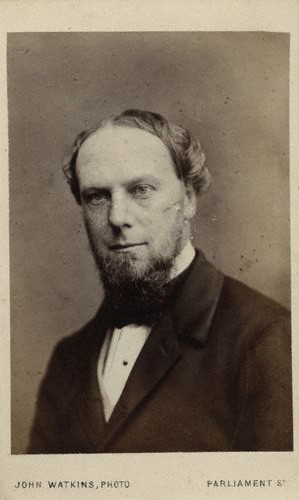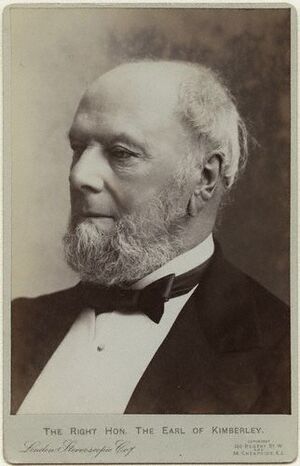John Wodehouse, 1st Earl of Kimberley facts for kids
Quick facts for kids
The Earl of Kimberley
|
|
|---|---|

Carte de visite showing the Earl of Kimberley, ca. 1868.
|
|
| Secretary of State for Foreign Affairs | |
| In office 10 March 1894 – 21 June 1895 |
|
| Monarch | Queen Victoria |
| Prime Minister | The Earl of Rosebery |
| Preceded by | The Earl of Rosebery |
| Succeeded by | The Marquess of Salisbury |
| Leader of the House of Lords Lord President of the Council |
|
| In office 18 August 1892 – 5 March 1894 |
|
| Monarch | Queen Victoria |
| Prime Minister | William Ewart Gladstone |
| Preceded by | The Marquess of Salisbury (Leader of Lords) The Earl of Cranbrook (President of Council) |
| Succeeded by | The Earl of Rosebery |
| Secretary of State for India | |
| In office 18 August 1892 – 10 March 1894 |
|
| Monarch | Victoria |
| Prime Minister | William Ewart Gladstone |
| Preceded by | The Viscount Cross |
| Succeeded by | Henry Fowler |
| In office 6 February 1886 – 20 July 1886 |
|
| Monarch | Victoria |
| Prime Minister | William Ewart Gladstone |
| Preceded by | Lord Randolph Churchill |
| Succeeded by | The Viscount Cross |
| In office 16 December 1882 – 9 June 1885 |
|
| Monarch | Victoria |
| Prime Minister | William Ewart Gladstone |
| Preceded by | Marquess of Hartington |
| Succeeded by | Lord Randolph Churchill |
| Chancellor of the Duchy of Lancaster | |
| In office 25 July 1882 – 28 December 1882 |
|
| Monarch | Queen Victoria |
| Prime Minister | William Ewart Gladstone |
| Preceded by | John Bright |
| Succeeded by | John George Dodson |
| Secretary of State for the Colonies | |
| In office 21 April 1880 – 16 December 1882 |
|
| Monarch | Victoria |
| Prime Minister | William Ewart Gladstone |
| Preceded by | Sir Michael Hicks Beach, Bt. |
| Succeeded by | The Earl of Derby |
| In office 6 July 1870 – 17 February 1874 |
|
| Monarch | Victoria |
| Prime Minister | William Ewart Gladstone |
| Preceded by | The Earl Granville |
| Succeeded by | The Earl of Carnarvon |
| Lord Keeper of the Privy Seal | |
| In office 9 December 1868 – 6 July 1870 |
|
| Monarch | Queen Victoria |
| Prime Minister | William Ewart Gladstone |
| Preceded by | The Earl of Malmesbury |
| Succeeded by | The Viscount Halifax |
| Lord Lieutenant of Ireland | |
| In office 1 November 1864 – 13 July 1866 |
|
| Monarch | Queen Victoria |
| Prime Minister | The Earl Russell |
| Preceded by | The Earl of Carlisle |
| Succeeded by | The Marquess of Abercorn |
| Parliamentary Under-Secretary of State for India | |
| In office 25 April 1864 – 16 November 1864 |
|
| Monarch | Queen Victoria |
| Prime Minister | The Viscount Palmerston |
| Preceded by | Hon. Thomas Baring |
| Succeeded by | Lord Dufferin and Clandeboye |
| Parliamentary Under-Secretary of State for Foreign Affairs | |
| In office 19 June 1859 – 15 August 1861 |
|
| Monarch | Queen Victoria |
| Prime Minister | The Earl of Aberdeen The Viscount Palmerston |
| Preceded by | William Vesey-FitzGerald |
| Succeeded by | Austen Henry Layard |
| In office 28 December 1852 – 5 July 1856 |
|
| Monarch | Queen Victoria |
| Prime Minister | The Earl of Aberdeen The Viscount Palmerston |
| Preceded by | Lord Stanley |
| Succeeded by | The Earl of Shelburne |
| Member of the House of Lords Lord Temporal |
|
| In office 8 January 1847 – 8 April 1902 Hereditary Peerage |
|
| Preceded by | The 2nd Lord Wodehouse |
| Succeeded by | The 2nd Earl of Kimberley |
| Personal details | |
| Born | 7 January 1826 Wymondham |
| Died | 8 April 1902 (aged 76) London |
| Nationality | British |
| Political party | Liberal Party |
| Spouses | Lady Florence FitzGibbon (d. 1895) |
| Children | 3 |
| Alma mater | Christ Church, Oxford |
John Wodehouse, 1st Earl of Kimberley (born 7 January 1826, died 8 April 1902) was an important British politician from the Liberal Party. He was known as Lord Wodehouse from 1846 to 1866. He held many government jobs in every Liberal government from 1852 to 1895. His most notable roles included Secretary of State for the Colonies and Foreign Secretary.
Contents
Early Life and Education
John Wodehouse was born in 1826 in Wymondham, Norfolk. He was the oldest son of Henry Wodehouse. In 1846, he became the third Baron Wodehouse after his grandfather passed away.
He went to school at Eton and then studied at Christ Church, Oxford. In 1847, he earned a top degree in classical studies.
Early Political Career (1852–1874)
John Wodehouse followed his family's political views and became a Liberal. From 1852 to 1856 and again from 1859 to 1861, he worked as the Parliamentary Under-Secretary of State for Foreign Affairs. This meant he helped the Foreign Secretary with international relations.
In 1856, he was a special representative to Russia. Later, in 1863, he went on a special trip to Copenhagen to try and solve a problem called the Schleswig-Holstein question, but it didn't work out.
In 1864, Kimberley became the Under-Secretary of State for India. Later that year, he was made Lord Lieutenant of Ireland. This role meant he was the Queen's representative in Ireland. While there, he had to deal with early signs of political unrest. Because of his work, he was given the title of Earl of Kimberley in 1866.
When the government changed in July 1866, he left his job. But in 1868, he joined Gladstone's government as Lord Privy Seal. In July 1870, he moved to become the Secretary of State for the Colonies. This was when huge diamond discoveries were happening in southern Africa. The city of Kimberley in South Africa was named after him. He also helped change British policy towards the independent Malay states, leading to the Pangkor Treaty of 1874. This treaty placed British advisors in those states.
Later Political Career (1875–1902)
After being out of government from 1874 to 1880, Lord Kimberley returned to the Colonial Office in Gladstone's next government. During this time, the Cape Colony gained more control over its own affairs, and British Columbia joined Canada. He was also in office during the First Boer War.
In 1882, he changed roles, first becoming Chancellor of the Duchy of Lancaster and then Secretary of State for India. He kept the India role for the rest of Gladstone's time in power (1882–1885, 1886, 1892–1894). From 1892 to 1894, he also held the job of Lord President of the Council.
In Lord Rosebery's government (1894–1895), he served as Foreign Secretary. During this period, he signed an important agreement called the Anglo-Japanese Treaty of Commerce and Navigation. As the leader of the Liberal party in the House of Lords, he was always dignified and a respected opponent.
Other Public Roles
On 5 April 1850, he joined the Canterbury Association. This group was formed to create a new colony in what is now the Canterbury Region on the South Island of New Zealand.
Lord Kimberley was also very interested in education. He was a member of the senate of the University of London for many years. In 1899, he became the university's chancellor.
Family Life
Lord Kimberley married Lady Florence FitzGibbon on 16 August 1847. She passed away in 1895. They had three children:
- John Wodehouse, 2nd Earl of Kimberley (1848–1932)
- Lady Alice Wodehouse (1850–1937), who married Hussey Packe.
- Hon. Armine Wodehouse (1860–1901)
John Wodehouse, 1st Earl of Kimberley, died in London on 8 April 1902, at the age of 76. His oldest son, John, took over his titles. The famous writer P. G. Wodehouse was a more distant relative of his.
Places Named After Him
Several places around the world were named after the 1st Earl of Kimberley:
- The Kimberley region in Western Australia.
- Kimberley, a town in South Africa.
- Kimberley, New Zealand, a small village in the Selwyn District of New Zealand.
- Kimberley Road and Kimberley Street in Hong Kong.
- Kimberley Street in George Town, Penang, Malaysia.
- Kimberley Park in Falmouth, Cornwall.
- County of Kimberley, a land division in South Australia.


